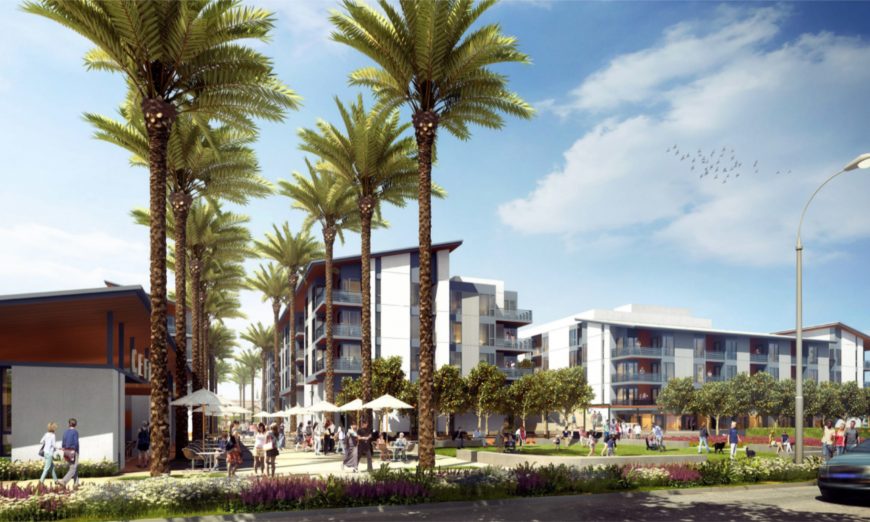On Aug. 8, Planning Commissioners recommended that City Council approve the final environmental review document, required rezoning and tentative vesting map for a residential project at 1834 Worthington Cr. Agrihood, a project that began to be conceptualized in 2003, is close to the San Jose border and sits across the street from the Westfield Valley Fair.
It’s being developed by Core Affordable Housing and designed by Steinberg Architects. If approved, it will bring a total of 361 dwelling units consisting of 160 mixed-income apartments,165 affordable senior apartments and 36 townhomes. A notable aspect of the proposal is a 1.5-acre agricultural area geared towards providing organic produce to the local community.
“This is a project that means a lot of things to many people,” Vince Cantore, senior development manager at Core Affordable Housing said at the Planning Commission meeting. “To the agriculturists in the audience, it means an opportunity to pay homage to the agricultural history of the BAREC site, while connecting people with local food production. To the seniors and senior veteran community, it means an opportunity for real affordable housing. To urbanites and Catalyze SV, it means an opportunity to increase density and push the residential envelope beyond what we’ve proposed.”
The project’s housing will be broken down into five separate buildings that all possess a similar architectural style. About 376 parking spots will be provided and copious community gathering spaces incorporated — including a farm-to-table restaurant, activities areas, performance space and pet area. The farming aspect will be organic and utilize “no-till” farming practices without a tractor.
A long line of residents waited to offer public comments regarding the project at the meeting. Most expressed excitement about the prospect of the plans finally coming to fruition after years of delay. Many were also very supportive of the mixed-income apartments and affordable senior housing as well as the local agricultural use.
Some neighbors to the south of the project site spoke about privacy concerns given that the new buildings will be much taller than their homes. Cantore said that vegetation screenings will be implemented on the project site to increase privacy.
In September, City Council will hear a presentation on Agrihood and then will vote on the project in October.
Commission leadership positions were decided at the meeting. Sudhanshu Jain is now Commission Chair, Raj Chahal will continue as Vice-Chair and Anthony Becker will hold the post of Secretary.
A presentation was given at the start of the meeting about the status of a Climate Action Plan update being conducted by staff. The Climate Action Plan was adopted in 2013 to help guide the City towards achieving greenhouse gas emission goals set by state legislature. Staff research found that Santa Clara is currently on track to reach the 2020 emissions reduction targets, however in order to meet the 2030 and 2050 goals, very stringent policies would have to be enacted.
Research showed that in 2016, 61 percent of the community’s emissions came from commercial sources, 29 percent from transportation, eight percent from residential, one percent from solid waste and one percent from water and waste water treatment. Staff commented that the breakdown is unusual because for most California cities transportation is the greatest emissions source. However, because of the high number of data centers in Santa Clara, the commercial source is considerable.
Emissions from data centers have actually been reduced by the mandated implementation of “economizer” technologies at all the sites in the City. However, Commission Chair Jain commented that a few of the centers have been able to achieve greater energy efficiency and so the requirements should be set to higher standard to help achieve reduction goals in coming decades.
Jain also recommended that the City devise a comprehensive Transportation Demand Management Plan, bolster carpooling and partner with the County to replace gas-powered landscaping equipment with electrical. He pointed out that Santa Clara’s rate of people driving alone in their vehicles is 85 percent compared to a national average of 75 percent, necessitating more sustainable transportation measures.
During the meeting a motion was also passed to approve use permits for two subdivision signs at 2051 and 2151 Mission College Blvd.







Although I’d much preferred to have seen BAREC become a community park or a true historical agricultural landmark celebrating Santa Clara’s agricultural history, I’m glad that the Planning Commission ignored CatalyzeSV’s calls for even higher buildings and density. Actually looking through the DEIR it was just two members of CatalyzeSV demanding changes – San Jose resident Kirk Vartan and Cupertino resident David Fung. I hope the city council approves this project to move forward and ignore those calls from CatalyzeSV as well.